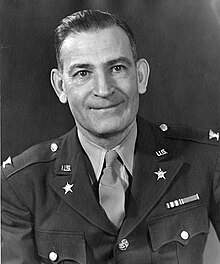Lee S. Gerow
| Lee Saunders Gerow | |
|---|---|
 |
|
| Born |
March 29, 1891 Petersburg, Virginia, United States |
| Died | May 19, 1982 (aged 91) Washington, D.C., United States |
| Buried | Arlington National Cemetery, Virginia, United States |
| Allegiance |
|
| Service/branch |
|
| Years of service | 1916–1948 |
| Rank |
|
| Unit |
|
| Commands held | 3rd Battalion, 379th Infantry Regiment 338th Infantry Regiment |
| Battles/wars |
World War I World War II |
| Awards |
Silver Star Legion of Merit Bronze Star (2) |
| Relations | Leonard T. Gerow (brother) |
Brigadier General Lee Saunders Gerow (March 29, 1891 – May 19, 1982) was a decorated United States Army officer with service in World War I and World War II. He was the younger brother of General Leonard T. Gerow.
Lee was born on March 29, 1891 in Petersburg, Virginia as a son of Leonard Rogers Gerow and Annie Eloise Saunders. He attended the Virginia Military Institute and graduated on June 18, 1913. Gerow did not enter the Army immediately, but first was appointed a Commandant of Bingham Military School in North Carolina. Subsequently he spent some time as Assistant Commandant of Columbia Military Academy in Tennessee, before he was commissioned a Second lieutenant in the Regular Army on November 30, 1916.
He was assigned to the 36th Infantry Regiment in 1916 and was stationed on the Mexican border at Del Rio, Texas during the Pancho Villa Expedition. He was also promoted to the rank of First lieutenant dating back to the November 30, 1916. Subsequently he was transferred to Fort Snelling, Minnesota, where he was appointed a Company commander. He was also promoted to the rank of Captain in the next year.
Gerow was promoted to the rank of Major on September 26, 1918 and transferred to the Camp Sherman, Ohio, where he assumed command of 3rd Battalion of the 379th Infantry Regiment. Here Gerow assisted in training of newly activated 95th Infantry Division, which was prepared for deployment overseas. On 11 November, the Armistice with Germany was signed, ending the hostilities. The division's deployment was cancelled and it was demobilized in December 1918.
...
Wikipedia
